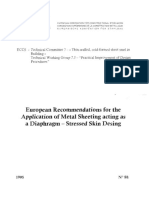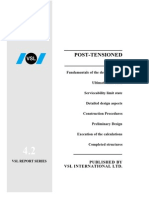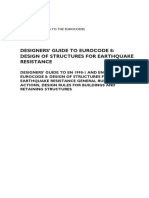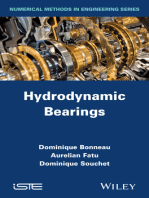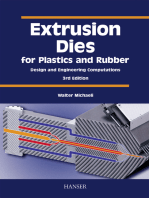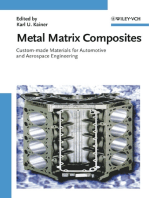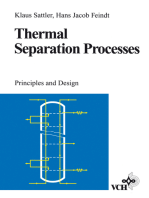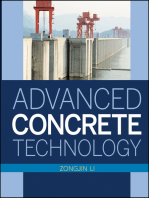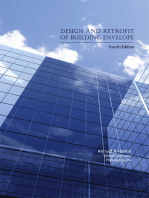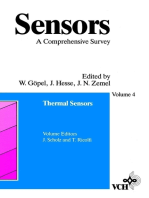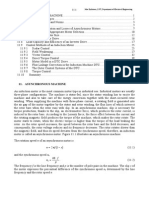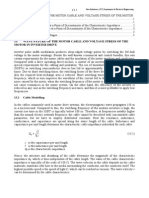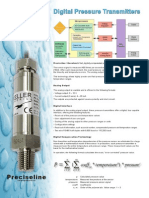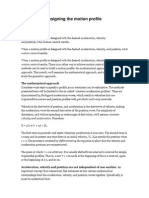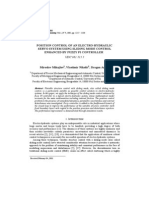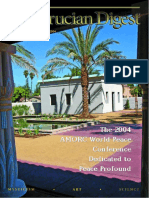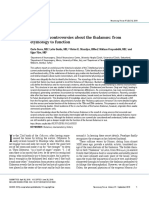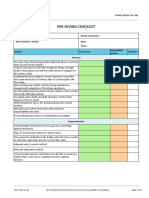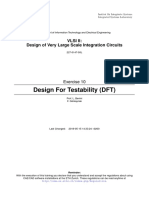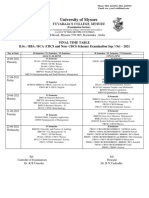No125 Contents
No125 Contents
Uploaded by
albertofgvCopyright:
Available Formats
No125 Contents
No125 Contents
Uploaded by
albertofgvCopyright
Available Formats
Share this document
Did you find this document useful?
Is this content inappropriate?
Copyright:
Available Formats
No125 Contents
No125 Contents
Uploaded by
albertofgvCopyright:
Available Formats
ECCS TC8 TWG 8.
4 Shells
Buckling of Steel Shells European Design Recommendations
5th Edition, 2008
All sections that are repeated word-for-word from EN 1993-1-6 are marked with a thick vertical line on the left hand side.
Buckling of Steel Shells - European Design Recommendations
Buckling of Steel Shells European Design Recommendations
N125, 5th edition, 2008 Published by: ECCS European Convention for Constructional Steelwork publications@steelconstruct.com www.steelconstruct.com All rights reserved. No parts of this publication may be reproduced, stored in a retrieval system, or transmitted in any form or by any means, electronic, mechanical, photocopying, recording or otherwise, without the prior permission of the copyright owner. ECCS assumes no liability with respect to the use for any application of the material and information contained in this publication. Copyright 2008 ECCS European Convention for Constructional Steelwork ISBN: 92-9147-000-92 Printed in Multicomp Lda, Mem Martins, Portugal Photo cover credits: Prof. J. Michael Rotter 2
Contents
Contents
Stability of Steel Shells: European Design Recommendations: Fifth Edition 2008 PART I: General recommendations for design against buckling
Chapter Title 1 2 3 4 5 6 7 8 9 Introduction Shell buckling behaviour and design concepts Scope, conventions, definitions, units, symbols and sign conventions Modelling of the shell Material assumptions Geometric tolerances and imperfections Rules for the plastic limit state assessment Rules for the buckling limit state assessment using design by global numerical analysis Rules for the buckling limit state assessment using stress design 11 21 33 47 57 69 83 95 147
PART II: Recommendations for particular shells
Chapter Title 10 11 12 13 14 15 16 17 18 19 20 Cylindrical shells of constant wall thickness under general loading Cylindrical shells of stepwise variable wall thickness Cylindrical shells under wind loading Conical shells and truncated conical shells under general loading Liquidfilled conical shells supported from below Spherical shells under uniform external pressure Toriconical and torispherical shells under uniform external and internal pressure Cylindrical shells with ring stiffeners under external pressure Cylindrical shells with longitudinal stiffeners under meridional compression Conical shells with longitudinal stiffeners under meridional compression Saddle or ring supported cylindrical shells 167 217 237 259 281 309 319 331 353 365 371
Buckling of Steel Shells - European Design Recommendations
Preface
Preface
This document is described as the 5th Edition of the ECCS European Recommendations for the Buckling of Steel Shells. It is the successor to the 4th Edition, published in 1988, which was very different in style, format and content, though some of the regulatory requirements of the 4th Edition are here retained in the 5th Edition. In the 20 years since the publication of the 4th Edition in 1988, much has changed in the field of metal shell buckling. Extensive research has been undertaken, much new knowledge has been developed, and powerful computational modelling has transformed the field, though much design is still conducted by hand calculation. These changes are reflected in this 5th Edition. Previous editions These European Recommendations have quite a long history: the First Edition was published in 1980, the 2nd in 1983, the 3rd in 1984 and the 4th Edition in 1988. The energetic chairmanship of Professor Vandepitte over this period made progress very rapid. But after these 4 editions in the space of only 9 years, a gap of 20 years ensued until the present 5th Edition. This 5th Edition has been some 10 years in gestation, partly because the development of the Eurocode on the Design of Shells (EN 1993-1-6, 2007) took up the energies of the same committee, and the 5th Edition could not be completed until that standard was also complete. The Eurocode EN 1993-1-6 was, in many respects, the successor to the 4th Edition, taking over the role of formal regulation of design of metal shells against buckling. Its scope was far greater than that of the 4th Edition, covering other failure modes apart from buckling, extended to include computational treatments for shells, and having a very strong and clear structure to permit application to shells under all loading and stress conditions. It also borrowed greatly from DIN 18800 Part 4 (1990), which had been developed for German-speaking countries in the late 1980s. The Eurocode was required to have a format, style, notation and terminology that is compatible with the remainder of the Eurocode standards (EN 1990 to EN 1999). This led to a number of changes in format and terminology relative to traditional shell design formulations, and these are all adopted into the 5th Edition of the Recommendations. The 5th Edition quotes extensively from the Eurocode EN 1993-1-6 (2007) and is completely compatible with that standard. However, the Eurocode has no commentary, so the meaning, limitations and origins of many rules are not always clear. This 5th Edition provides an extensive commentary on the existing rules relating to buckling in the Eurocode, but extends far beyond it in giving recommendations, expansions, advice and warnings, explanations and examples, all of which should give the user considerably more insight and confidence in applying the rules of EN 1993-1-6. Structure of the document This 5th Edition is divided into two parts. Part I sets out the basic information and general procedures required to undertake all shell buckling calculations according to EN 1993-1-6. It describes the methodology and conceptual principles for numerical analysis, either to derive the basic data that can be used in a straightforward buckling design by hand calculation, or to replace parts of this calculation with numerical assessments, or to carry out a buckling design that is completely based on numerical assessment. 5
Buckling of Steel Shells - European Design Recommendations
Part II sets out the detailed information for hand calculation procedures when a shell of a particular geometry is being designed for a particular loading condition. Many well-proven engineering formulas, empirical data and simplified rules extracted from numerical parametric studies have been included in this part. In particular, Part II contains radically updated versions of the rules set out in the 4th Edition of the ECCS Recommendations. The Drafting Committee ECCS TWG 8.4 In the extended period since the 4th Edition was published in 1988, the membership of the drafting committee has seen several changes. Chairmanship of the committee was first with Dr Lars Samuelsen, was then taken over by Prof. Herbert Schmidt, and finally passed to Prof. J. Michael Rotter. The efforts of each of these chairmen to progress the work towards its final form are here acknowledged. The good work of the secretaries to the committee during this period, Prof. Marios Chryssanthopoulos, Prof. Carlo Poggi, Prof. Werner Guggenberger and Prof. Spyros Karamanos is also gratefully acknowledged. Past members of the committee who contributed greatly during the period 1989-2008 were: Dr Lars A. Samuelsen Prof. Patrick J. Dowling Prof. Maria Esslinger Prof. Gerry D. Galletly Dr Jonas Odland Prof. J. Rath Sweden UK Germany UK Norway Belgium
Current members of the committee (2008) who are responsible for its full content, and who have all participated and contributed to all chapters are: Name Dr Jan Blachut Prof. Marios Chryssanthopoulos Prof. Alain Combescure Dr Cornelia Doerich Prof. Richard Greiner Prof. A.M. (Nol) Gresnigt Prof. Werner Guggenberger Dr J. Mark F.G. Holst Prof. Jean-Franois Jullien Prof. Spyros Karamanos Prof. Vlastimil Kupka Prof. Guy Lagae Prof. Ali Limam Prof. Jakub Marcinowski Prof. Carlo Poggi Prof. J. Michael Rotter Prof. Helmut Saal Prof. Herbert Schmidt Prof. Werner Schneider Prof. Andrea Spagnoli 6 Country UK UK France UK/Germany Austria Netherlands Austria Germany/UK France Greece Czech Republic Belgium France Poland Italy UK Germany Germany Germany Italy Membership Full Corresponding, formerly Full Full Corresponding Full Full Full Corresponding Full Corresponding Full Full Corresponding Corresponding Corresponding, formerly Full Full Full Full Corresponding Corresponding
Preface
Prof. Jin-Guang Teng Dr Wesley Vanlaere Prof. Walter Wunderlich
Hong Kong, China Corresponding Belgium Corresponding Germany Full
Key contributions of members to chapters All members of the committee effectively contributed in some way to all of the chapters in these Recommendations. But because each chapter was essentially written by one or a few individuals, they are named in the text as the principal authors of each chapter. However, the very significant contributions of others to particular chapters are here also noted. Chapter Title 1 2 3 4 5 6 7 8 Principal authors and further substantial contributors ()
9 10 11 12 13 14 15 16 17
Introduction Shell buckling behaviour and design concepts Chryssanthopoulos, Rotter Scope, conventions, definitions, units, symbols and sign conventions Modelling of the shell Rotter, Schmidt (Wunderlich) Material assumptions Rotter, Gresnigt (Schmidt) Geometric tolerances and imperfections Rotter, Schmidt (Gresnigt) Rules for the plastic limit state assessment Rotter (Gresnigt) Rules for the buckling limit state assessment Schmidt, Rotter, using design by global numerical analysis (Karamanos, Schneider, Guggenberger, Vanlaere, Doerich, Holst) Rules for the buckling limit state assessment Schmidt, Rotter, Greiner using stress design (Karamanos, Holst) Cylindrical shells of constant wall thickness Schmidt, Rotter under general loading (Karamanos, Limam) (flow charts by Poggi and Vanlaere) Cylindrical shells of stepwise variable wall Greiner, Rotter thickness (Karamanos, Doerich, Schmidt) Cylindrical shells under wind loading Greiner, Guggenberger, Schneider (Schmidt, Rotter, Marcinowski) Conical shells and truncated conical shells un- Greiner, Poggi der general loading (Schmidt, Lagae, Vanlaere) (Flow charts by Poggi and Vanlaere) Liquidfilled conical shells supported from Lagae, Guggenberger, Vanlaere below Spherical shells under uniform external presWunderlich sure (Karamanos) Toriconical and torispherical shells under uni- Wunderlich form external and internal pressure Cylindrical shells with ring stiffeners under Schmidt, Greiner external pressure 7
Buckling of Steel Shells - European Design Recommendations
18 19 20
Cylindrical shells with longitudinal stiffeners under meridional compression Conical shells with longitudinal stiffeners under meridional compression Saddle or ring supported cylindrical shells
Schmidt, Samuelson (Rotter) Chryssanthoupolos, Spagnoli Krupka (Schmidt, Rotter, Karamanos)
Proposed 6th Edition The members of the committee are very aware that simple advice on many critically important practical problems has not been given in the 5th Edition. The original plan was to include many more chapters. However, in the interests of completing the publication in a reasonable time, these chapters were omitted. The following subjects are expected to be treated in a focused manner in a forthcoming 6th Edition. GMNIA analysis and interpretation advice for complex load cases Cylinders with cut-outs Cylinders on local supports at the base Cylinders on local brackets and engaged columns Bending and transverse shear in long cylinders Bending and transverse shear in short cylinders Cylinder-cone junctions in chimneys, towers and masts Cone-cylinder junctions in silos and tanks Shallow conical roofs and eaves stiffeners Corrugated stiffened and unstiffened cylinders for silos Disclaimer The opinions expressed in these Recommendations are those of the authors and members of the drafting committee and are not necessarily those of the ECCS. Every effort has been made to ensure accuracy in these Recommendations, but the publisher, the ECCS and the authors cannot accept responsibility for any loss, damage or other consequence resulting from the use of this information. Anyone making use of the information or material contained in these Recommendations, in whole or in part, does so at his or her own risk and assumes any and all liability from such use.
Preface
Closure The committee hopes that the reader will find much useful information in this 5th Edition of the European Recommendations, will forgive any errors in the document, and will provide feedback to the committee on any issues that should be reconsidered. J.M. Rotter m.rotter@ed.ac.uk Edinburgh July 2008
Buckling of Steel Shells - European Design Recommendations
10
You might also like
- Ih Navistar Dt466e 530e Service ManualDocument206 pagesIh Navistar Dt466e 530e Service Manualaviseur100% (9)
- Handbook of PVC Pipe Design and Construction: (First Industrial Press Edition)From EverandHandbook of PVC Pipe Design and Construction: (First Industrial Press Edition)No ratings yet
- Chapter 9 Screw ConveyorsDocument7 pagesChapter 9 Screw ConveyorsMarew Getie100% (1)
- Hollow Sections 2nd EdtDocument240 pagesHollow Sections 2nd Edtksuscribdacct100% (3)
- ITM CaseDocument10 pagesITM CasePramod JuyalNo ratings yet
- Ii IiDocument263 pagesIi IiNuno Telmo LopesNo ratings yet
- Hollow Sections in Structural Applications 2nd EditionDocument240 pagesHollow Sections in Structural Applications 2nd Edition_at_to_100% (2)
- 3.design and Weight Optimization of Lift Base PlateDocument40 pages3.design and Weight Optimization of Lift Base Plateumesh KudalkarNo ratings yet
- Post Tensioned SlabsDocument44 pagesPost Tensioned SlabsMaad Ahmed Al-Maroof100% (2)
- Reinforced Concrete DesignDocument202 pagesReinforced Concrete DesignDidi Gi95% (20)
- Structural Hollow SectionsDocument187 pagesStructural Hollow SectionsvijayanmksNo ratings yet
- Designers Guide To EN1991!1!2, 1992-1-2, 1993-1-2 and 1994-1-2 Handbook For Fire DesignDocument18 pagesDesigners Guide To EN1991!1!2, 1992-1-2, 1993-1-2 and 1994-1-2 Handbook For Fire DesignJon Wong0% (1)
- Advances in Corrosion Control and Materials in Oil and Gas ProductionDocument472 pagesAdvances in Corrosion Control and Materials in Oil and Gas ProductionDaodu Olugbenga OlusegunNo ratings yet
- Designers' Guide To Eurocode 8: Design of Structures For Earthquake ResistanceDocument288 pagesDesigners' Guide To Eurocode 8: Design of Structures For Earthquake ResistanceVithun ThayNo ratings yet
- W. H. Mosley, J. H. Bungey Reinforced Concrete Design 1991Document202 pagesW. H. Mosley, J. H. Bungey Reinforced Concrete Design 1991Jack GallagherNo ratings yet
- Hollow SectionsDocument199 pagesHollow Sectionsmandregomes100% (2)
- Metallurgy and Mechanics of Welding: Processes and Industrial ApplicationsFrom EverandMetallurgy and Mechanics of Welding: Processes and Industrial ApplicationsRegis BlondeauNo ratings yet
- Cable Supported Bridges: Concept and DesignFrom EverandCable Supported Bridges: Concept and DesignRating: 5 out of 5 stars5/5 (1)
- Plates and Shells for Smart Structures: Classical and Advanced Theories for Modeling and AnalysisFrom EverandPlates and Shells for Smart Structures: Classical and Advanced Theories for Modeling and AnalysisRating: 5 out of 5 stars5/5 (1)
- Extrusion Dies for Plastics and Rubber: Design and Engineering ComputationsFrom EverandExtrusion Dies for Plastics and Rubber: Design and Engineering ComputationsNo ratings yet
- Construction Reliability: Safety, Variability and SustainabilityFrom EverandConstruction Reliability: Safety, Variability and SustainabilityJulien BarothNo ratings yet
- Metal Matrix Composites: Custom-made Materials for Automotive and Aerospace EngineeringFrom EverandMetal Matrix Composites: Custom-made Materials for Automotive and Aerospace EngineeringKarl U. KainerNo ratings yet
- Home Instruction for Sheet Metal Workers - Based on a Series of Articles Originally Published in 'Metal Worker, Plumber and Steam Fitter'From EverandHome Instruction for Sheet Metal Workers - Based on a Series of Articles Originally Published in 'Metal Worker, Plumber and Steam Fitter'No ratings yet
- Thermal Separation Processes: Principles and DesignFrom EverandThermal Separation Processes: Principles and DesignRating: 1 out of 5 stars1/5 (1)
- Membrane Gas SeparationFrom EverandMembrane Gas SeparationBenny FreemanNo ratings yet
- Ceramic Matrix Composites: Fiber Reinforced Ceramics and their ApplicationsFrom EverandCeramic Matrix Composites: Fiber Reinforced Ceramics and their ApplicationsWalter KrenkelNo ratings yet
- Composite Technology: Prepregs and Monolithic Part Fabrication TechnologiesFrom EverandComposite Technology: Prepregs and Monolithic Part Fabrication TechnologiesNo ratings yet
- Triangulation - Applied to Sheet Metal Pattern Cutting - A Comprehensive Treatise for Cutters, Draftsmen, Foremen and Students: Progressing from the Simplest Phases of the Subject to the Most Complex Problems Employed in the Development of Sheet Metal Patterns with Practical Solutions of Numerous Problems of Frequent Occurrence in Sheet Metal ShopsFrom EverandTriangulation - Applied to Sheet Metal Pattern Cutting - A Comprehensive Treatise for Cutters, Draftsmen, Foremen and Students: Progressing from the Simplest Phases of the Subject to the Most Complex Problems Employed in the Development of Sheet Metal Patterns with Practical Solutions of Numerous Problems of Frequent Occurrence in Sheet Metal ShopsRating: 5 out of 5 stars5/5 (1)
- Phase Transformations in Multicomponent MeltsFrom EverandPhase Transformations in Multicomponent MeltsDieter M. HerlachNo ratings yet
- A Practical Workshop Companion for Tin, Sheet Iron, and Copper Plate Workers: Containing Rules for Describing Various Kinds of Patterns used by Tin, Sheet Iron, and Copper Plate Workers, Practical Geometry, Mensuration of Surfaces and Solids, Tables of the Weights of Metals, Lead Pipe, Tables of Areas and CircumferencesFrom EverandA Practical Workshop Companion for Tin, Sheet Iron, and Copper Plate Workers: Containing Rules for Describing Various Kinds of Patterns used by Tin, Sheet Iron, and Copper Plate Workers, Practical Geometry, Mensuration of Surfaces and Solids, Tables of the Weights of Metals, Lead Pipe, Tables of Areas and CircumferencesNo ratings yet
- Electrochemical Surface Modification: Thin Films, Functionalization and CharacterizationFrom EverandElectrochemical Surface Modification: Thin Films, Functionalization and CharacterizationNo ratings yet
- High-Speed Steel - The Development, Nature, Treatment, and use of High-Speed Steels, Together with Some Suggestions as to the Problems Involved in their UseFrom EverandHigh-Speed Steel - The Development, Nature, Treatment, and use of High-Speed Steels, Together with Some Suggestions as to the Problems Involved in their UseNo ratings yet
- Heat-Treatment of Steel: A Comprehensive Treatise on the Hardening, Tempering, Annealing and Casehardening of Various Kinds of Steel: Including High-speed, High-Carbon, Alloy and Low Carbon Steels, Together with Chapters on Heat-Treating Furnaces and on Hardness TestingFrom EverandHeat-Treatment of Steel: A Comprehensive Treatise on the Hardening, Tempering, Annealing and Casehardening of Various Kinds of Steel: Including High-speed, High-Carbon, Alloy and Low Carbon Steels, Together with Chapters on Heat-Treating Furnaces and on Hardness TestingRating: 1 out of 5 stars1/5 (1)
- Sensors, Thermal SensorsFrom EverandSensors, Thermal SensorsWolfgang GöpelNo ratings yet
- Concrete Structures: Repair, Rehabilitation and StrengtheningFrom EverandConcrete Structures: Repair, Rehabilitation and StrengtheningNo ratings yet
- 1083ch4 - 4-Cones, Crayons, Labels, Paints, and Pellets PDFDocument5 pages1083ch4 - 4-Cones, Crayons, Labels, Paints, and Pellets PDFcentaury2013No ratings yet
- An Improved Approach For Connecting VSD and Electric Motors PDFDocument8 pagesAn Improved Approach For Connecting VSD and Electric Motors PDFalbertofgvNo ratings yet
- BUFAB BUMAX Brochyre 2013 PDFDocument30 pagesBUFAB BUMAX Brochyre 2013 PDFalbertofgvNo ratings yet
- Kaytto11 enDocument52 pagesKaytto11 enalbertofgvNo ratings yet
- DTX Compact OTDR: Turn Your Cable Tester Into An OTDRDocument4 pagesDTX Compact OTDR: Turn Your Cable Tester Into An OTDRalbertofgvNo ratings yet
- Wave Nature of The Motor Cable and Voltage Stress of The Motor in Inverter DriveDocument9 pagesWave Nature of The Motor Cable and Voltage Stress of The Motor in Inverter DrivealbertofgvNo ratings yet
- Digital Transmitter OverviewDocument2 pagesDigital Transmitter OverviewalbertofgvNo ratings yet
- Methods For Designing The Motion ProfileDocument2 pagesMethods For Designing The Motion ProfilealbertofgvNo ratings yet
- Position Control of An Electro-Hydraulic Servo System Using Sliding Mode Control Enhanced by Fuzzy Pi ControllerDocument14 pagesPosition Control of An Electro-Hydraulic Servo System Using Sliding Mode Control Enhanced by Fuzzy Pi ControlleralbertofgvNo ratings yet
- 04 DambreakDocument13 pages04 DambreakalbertofgvNo ratings yet
- Amjad J. Aref, PH.D.: DucationDocument22 pagesAmjad J. Aref, PH.D.: DucationalbertofgvNo ratings yet
- Histar A913-65 S460 in Houston Stadium Retractable RoofDocument9 pagesHistar A913-65 S460 in Houston Stadium Retractable RoofalbertofgvNo ratings yet
- User Guide WMS 19CDocument352 pagesUser Guide WMS 19CRady KotbNo ratings yet
- Nurses and Medication ErrorDocument6 pagesNurses and Medication Errorazida90No ratings yet
- GINA 2022 Whats New SlidesDocument52 pagesGINA 2022 Whats New SlidesYulia DevinaNo ratings yet
- 2022 Polban CandidatesDocument7 pages2022 Polban CandidatesREYHANZ REVYZEIN -No ratings yet
- Kluber Summit RHTSeries - Pds - 1 PDFDocument1 pageKluber Summit RHTSeries - Pds - 1 PDFJavier AffifNo ratings yet
- APSS Ebook - ShaNacinoDocument41 pagesAPSS Ebook - ShaNacinoElmary CaubananNo ratings yet
- Settlement of Shallow Footings: CIV4249: Foundation EngineeringDocument47 pagesSettlement of Shallow Footings: CIV4249: Foundation EngineeringCasovi StatikaNo ratings yet
- AMORC - O Rosacruz Vol 82 Número 3 - 2004Document32 pagesAMORC - O Rosacruz Vol 82 Número 3 - 2004Ricardo UchoaNo ratings yet
- Liquidation-ValueDocument23 pagesLiquidation-Valueherrera.angelaNo ratings yet
- Artigo TalamoDocument10 pagesArtigo Talamohercules marceloNo ratings yet
- UNIT 4 Standard Costing and Variance AnalysisDocument39 pagesUNIT 4 Standard Costing and Variance Analysisannabelle albaoNo ratings yet
- As You Like It - William ShakespeareDocument113 pagesAs You Like It - William Shakespearezerostriker12No ratings yet
- Risk Assessment and Allocation in Nigerian Oil and Gas Projects Oil Gas Projects PDFDocument10 pagesRisk Assessment and Allocation in Nigerian Oil and Gas Projects Oil Gas Projects PDFdanudmwNo ratings yet
- Datasheet 2Document2 pagesDatasheet 2Mehbubnew gtNo ratings yet
- Deme Qhses CHL 062 eDocument2 pagesDeme Qhses CHL 062 eAndrei SavuNo ratings yet
- Cohesion CouplingDocument10 pagesCohesion CouplingMansi AgarwalNo ratings yet
- Memuji Tuhan Yang BenarDocument16 pagesMemuji Tuhan Yang Benarrina lontaanNo ratings yet
- The Character of PortiaDocument31 pagesThe Character of PortiaАлександра Илић100% (1)
- Coursera SQL CertificateDocument1 pageCoursera SQL Certificateapi-291449456No ratings yet
- Microsoft Dynamics AX Presentation2Document21 pagesMicrosoft Dynamics AX Presentation2tarek abibNo ratings yet
- SaiTharun KollampallySEDocument1 pageSaiTharun KollampallySEsai tejaNo ratings yet
- Cardiovascular SystemDocument39 pagesCardiovascular SystemdumbledoreaaaaNo ratings yet
- The Form of Modal AuxiliariesDocument6 pagesThe Form of Modal AuxiliariesBlaise MaitudiNo ratings yet
- Design For Testability (DFT) : Vlsi Ii: Design of Very Large Scale Integration CircuitsDocument22 pagesDesign For Testability (DFT) : Vlsi Ii: Design of Very Large Scale Integration CircuitsSiam HasanNo ratings yet
- DriveRack PA Preset List PDFDocument1 pageDriveRack PA Preset List PDFMerry Flores UrbinaNo ratings yet
- OREAS 992 CertificateDocument5 pagesOREAS 992 CertificateVivianne PerezNo ratings yet
- Final UG Time Table 2021Document3 pagesFinal UG Time Table 2021Sanjay RainaNo ratings yet









